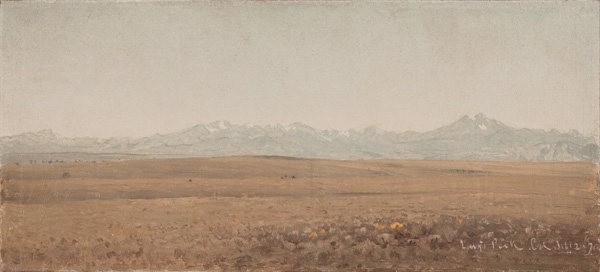
In this series, noted painter Joseph McGurl discusses plein air paintings by past masters that he finds instructive or inspiring. This week: Sanford R. Gifford’s “Long’s Peak, Colorado.”
Sanford R. Gifford (1823-1880) was one of the most prominent of the later-period Hudson River School painters and was known for his sensitivity to color harmony and light. As well as painting in New England, Europe, and the Middle East, he journeyed west to paint the American frontier. This study illustrates Gifford’s unique ability to control color and value and shows remarkable restraint in avoiding the temptation to include some narrative content or a strong accent of color or value to enliven the scene. By avoiding this temptation, Gifford gives us a unique experience that conveys the topography and climatology of a particular day in the West, while giving the impression of immense space. With the simplicity of the composition, “Long’s Peak, Colorado” could be considered a predecessor of the color field paintings painted by New York abstractionists almost a century later.
The paint is applied quite thinly, as was characteristic of Gifford’s plein air work. Gifford often indicated form by taking advantage of the transparent qualities in his colors. By painting thinly, he could then use a dry brush and wipe the color off certain areas, allowing the lighter tone of the panel to show through. Drawing in the wet paint gives the impression of undulating landscape and foliage, and Gifford employs this technique here in the rendering of the distant mountains and the foreground grasses. The advantage of his method is that it just barely changes the color and value, so he can create subtle shifts similar to the effects attained by glazing.
“Long’s Peak” is one of those paintings where its complexity is overwhelmed by its apparent simplicity. As we stare at it, our eyes adjust to the subtle value shifts and to the topographical detail: The plain is a series of undulating hills. There is a faint cloud shadow on the rise in the center. Small accents of distant foliage appear. The mountains are a carefully observed collection of crags and peaks, with accents of the previous winter’s snow. Few artists are capable of painting with the simplicity, harmony, and sensitivity of Sanford R. Gifford.




